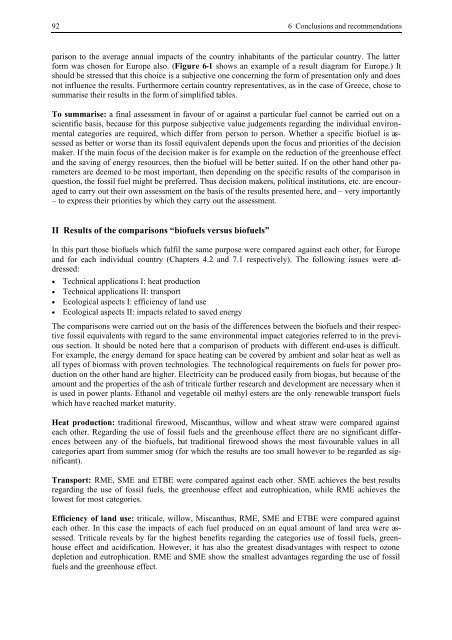BIOENERGY FOR EUROPE: WHICH ONES FIT BEST?
BIOENERGY FOR EUROPE: WHICH ONES FIT BEST?
BIOENERGY FOR EUROPE: WHICH ONES FIT BEST?
You also want an ePaper? Increase the reach of your titles
YUMPU automatically turns print PDFs into web optimized ePapers that Google loves.
92 6 Conclusions and recommendations<br />
parison to the average annual impacts of the country inhabitants of the particular country. The latter<br />
form was chosen for Europe also. (Figure 6-1 shows an example of a result diagram for Europe.) It<br />
should be stressed that this choice is a subjective one concerning the form of presentation only and does<br />
not influence the results. Furthermore certain country representatives, as in the case of Greece, chose to<br />
summarise their results in the form of simplified tables.<br />
To summarise: a final assessment in favour of or against a particular fuel cannot be carried out on a<br />
scientific basis, because for this purpose subjective value judgements regarding the individual environmental<br />
categories are required, which differ from person to person. Whether a specific biofuel is assessed<br />
as better or worse than its fossil equivalent depends upon the focus and priorities of the decision<br />
maker. If the main focus of the decision maker is for example on the reduction of the greenhouse effect<br />
and the saving of energy resources, then the biofuel will be better suited. If on the other hand other parameters<br />
are deemed to be most important, then depending on the specific results of the comparison in<br />
question, the fossil fuel might be preferred. Thus decision makers, political institutions, etc. are encouraged<br />
to carry out their own assessment on the basis of the results presented here, and – very importantly<br />
– to express their priorities by which they carry out the assessment.<br />
II Results of the comparisons “biofuels versus biofuels”<br />
In this part those biofuels which fulfil the same purpose were compared against each other, for Europe<br />
and for each individual country (Chapters 4.2 and 7.1 respectively). The following issues were addressed:<br />
• Technical applications I: heat production<br />
• Technical applications II: transport<br />
• Ecological aspects I: efficiency of land use<br />
• Ecological aspects II: impacts related to saved energy<br />
The comparisons were carried out on the basis of the differences between the biofuels and their respective<br />
fossil equivalents with regard to the same environmental impact categories referred to in the previous<br />
section. It should be noted here that a comparison of products with different end-uses is difficult.<br />
For example, the energy demand for space heating can be covered by ambient and solar heat as well as<br />
all types of biomass with proven technologies. The technological requirements on fuels for power production<br />
on the other hand are higher. Electricity can be produced easily from biogas, but because of the<br />
amount and the properties of the ash of triticale further research and development are necessary when it<br />
is used in power plants. Ethanol and vegetable oil methyl esters are the only renewable transport fuels<br />
which have reached market maturity.<br />
Heat production: traditional firewood, Miscanthus, willow and wheat straw were compared against<br />
each other. Regarding the use of fossil fuels and the greenhouse effect there are no significant differences<br />
between any of the biofuels, but traditional firewood shows the most favourable values in all<br />
categories apart from summer smog (for which the results are too small however to be regarded as significant).<br />
Transport: RME, SME and ETBE were compared against each other. SME achieves the best results<br />
regarding the use of fossil fuels, the greenhouse effect and eutrophication, while RME achieves the<br />
lowest for most categories.<br />
Efficiency of land use: triticale, willow, Miscanthus, RME, SME and ETBE were compared against<br />
each other. In this case the impacts of each fuel produced on an equal amount of land area were assessed.<br />
Triticale reveals by far the highest benefits regarding the categories use of fossil fuels, greenhouse<br />
effect and acidification. However, it has also the greatest disadvantages with respect to ozone<br />
depletion and eutrophication. RME and SME show the smallest advantages regarding the use of fossil<br />
fuels and the greenhouse effect.

















